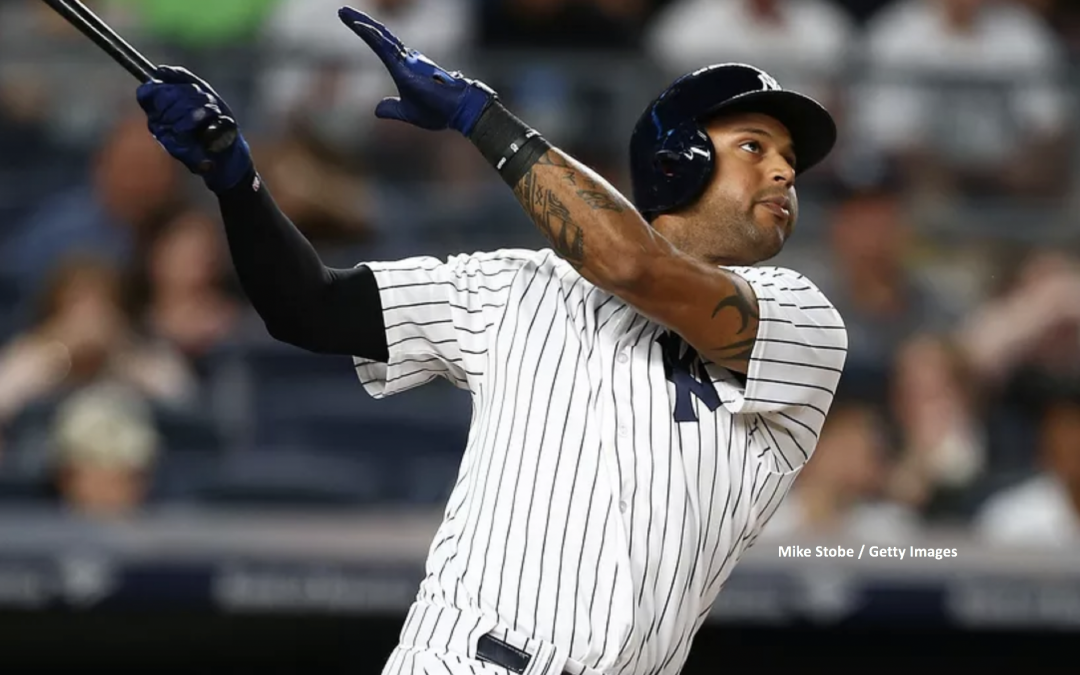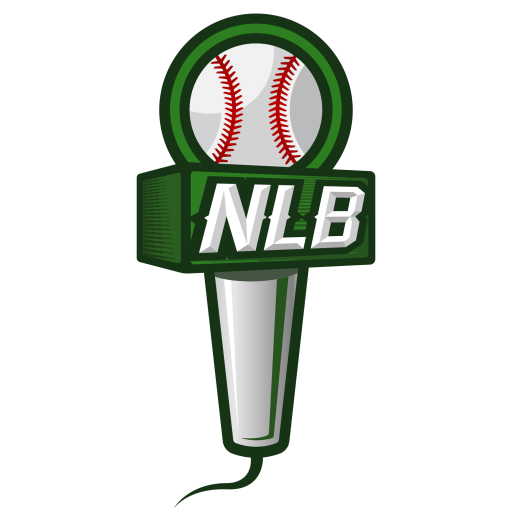The New York Yankees have less than a 3% chance of winning their division according to FanGraphs playoff odds. They recently got swept by the Boston Red Sox in a 4-game set at Fenway park at the beginning of the month, essentially handing the AL East crown to the Sox on their way out of Beantown. Saying that it is a long shot for the Yankees to win the AL East is an understatement. Their ace, Luis Severino, who looked untouchable in the first half of the season, has slipped in the second half to the tune of a 7.96 ERA and a 5.12 FIP and only 0.1 WAR. With no other great options behind him in their rotation, the Yanks may have no choice but to bullpen a wild-card game against the Athletics, Mariners, or Astros (yes, you read that right). Not only is their rotation underperforming, their offense has regressed significantly as well. Greg Bird has had a disastrous season to this point (88 wRC+, 0.2 WAR), and Gleyber Torres has run into his own issues since coming back from the DL on July 25th. On top of that, superstar Aaron Judge may miss more time than originally expected with a broken wrist. Things could be better in the Big Apple.
A big reason the Yankees are still on pace to win 100 games is their outfield play. We knew Giancarlo Stanton would be good. Brett Gardner is an established veteran who consistently puts up solid numbers. Aaron Judge is a future MVP. All of these are fine players, with many awards and All-Star appearances to show for it, but there is one other outfielder that is improving upon a breakout season last year in pinstripes: Aaron Hicks. Before entering the 2017 season, Hicks’ career high in WAR (via FanGraphs) was 2.0- what you would expect from an average everyday big leaguer. Last season, Hicks was better than average, putting together a 3.3 WAR campaign while slashing (.266/.372/.475) with a 127 wRC+ and solid defense. A big reason for his turnaround in 2017 has already been documented here (TL; DR Hicks has been much more disciplined at the plate along with crushing pitches up in the zone).
This year, Hicks has been even better. We’re still in August, and he’s already been worth 3.9 WAR while slashing (.253/.366/.477) with 20 home runs. A switch hitter, Hicks is valuable against both righties and lefties with an identical 130 wRC+ from both sides of the plate. Keep in mind he is doing all of this while playing a premium position on the other side of the ball. I know public defensive metrics are not the most reliable, but Hicks’ 6.8 UZR/150 is 3rd best in the AL among centerfielders while he also ranks 3rd by FanGraphs Defensive metric. To put the icing on the cake, Hicks may have the strongest arm in the majors. He currently owns the fastest ball ever thrown by a position player via Statcast, topping out at a whopping 105.5 mph.
Earlier this season, Travis Sawchick, who recently joined the FiveThirtyEight staff, wrote about Hicks’ offensive improvements and touched on his improved plate discipline and propensity to pull the ball more with the short porch in right field at Yankee Stadium II. However, I want to dig a little deeper because Hicks is putting himself in some elite company in the second half of the season. Some time ago, Hicks realized he could do more damage on pitches up in the zone. When he made this revelation, I don’t know. Maybe it was Spring Training, or watching film in the offseason of 2016, it doesn’t really matter. What matters is Hicks is proving 2017 wasn’t a fluke; we may be looking at one of the best centerfielders in the game today. I’d like to show you where Hicks has been concentrating his swings this year relative to last season, here is his swing percentage by location in 2017:
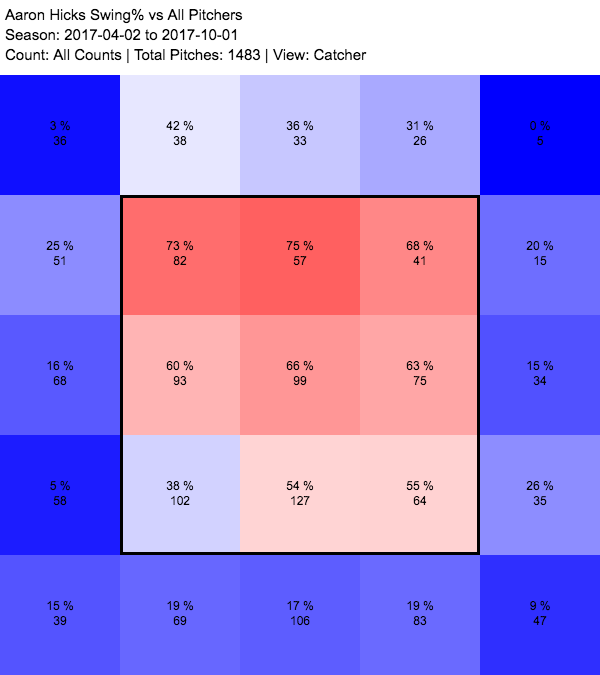
Anything at the knees and lower wasn’t all that interesting to Hicks. This season, he’s locked in even more on pitches not just up, but in the middle of the plate:
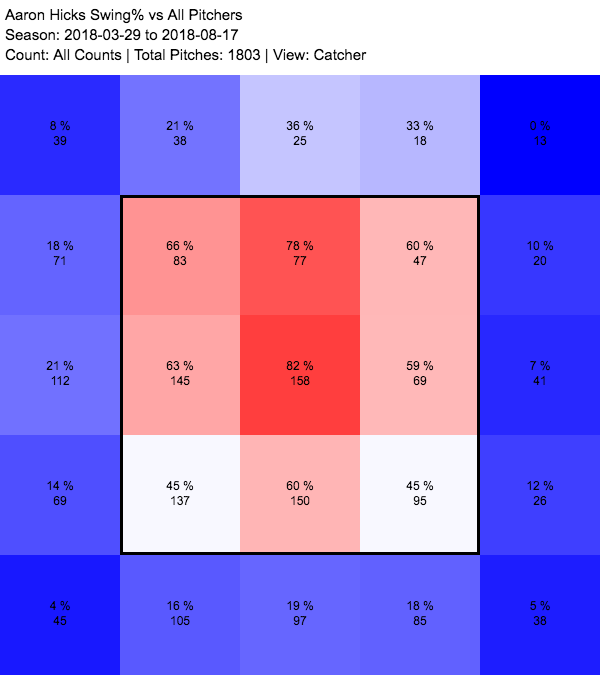
Hicks knows what pitches he needs to swing at. I don’t think the swing chart above makes him all that unique; pitches on the corners and at the knees are harder to hit than pitches over the middle of the plate. Like almost every other hitter in the majors, Hicks is obviously better when ahead in the count. Luckily for him, this has been happening often. Below are the 5 hitters in the majors who see the lowest amount of first pitch strikes this season:
| Player | First Pitch Strike % |
| Aaron Hicks | 52.5% |
| Jason Kipnis | 52.8% |
| Rhys Hoskins | 52.9% |
| Matt Carpenter | 52.9% |
| Jose Ramirez | 53.1% |
Pitchers have been falling behind Hicks more than any other hitter in the majors. It’s not as difficult to have higher walk and power numbers when a hitter is ahead in the count, he’s in the driver’s seat. Some of the other hitters mentioned here are very good: two are MVP candidates in Matt Carpenter and Jose Ramirez and another is one of the better young players in the game in Rhys Hoskins. On the other hand, being ahead in the count doesn’t always lead to success, cc: Jason Kipnis.
By this point you get that Hicks is now a disciplined hitter. There’s one more thing I want to show you to really put this in perspective. First, a graph of all qualified hitters in the AL for the second half of the season. On the X-axis is K-BB%, the Y-axis is wRC+, Hicks is the point in red:
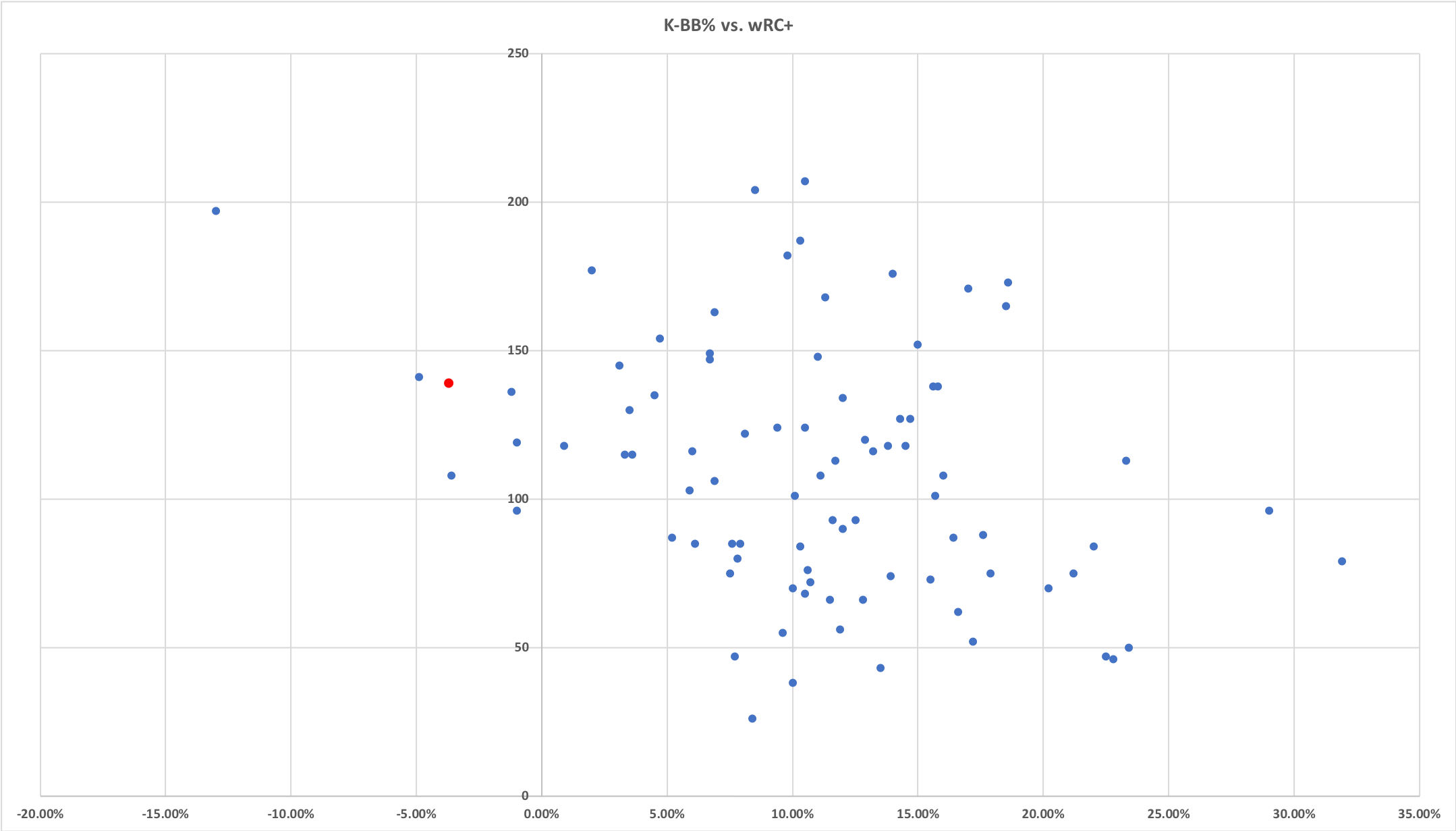
You’ll notice there are seven hitters who have walked at a higher rate than they have struck out in the second half of the season. You’ll also notice that Jose Ramirez is currently on another planet (he’s the point in the very top left). Here are those hitters with higher walk rates than strikeout rates in table form:
| Player | K-BB% | wRC+ |
| Jose Ramirez | -13.0% | 197 |
| Francisco Lindor | -4.9% | 141 |
| Aaron Hicks | -3.7% | 139 |
| Michael Brantley | -3.6% | 108 |
| Victor Martinez | -1.2% | 136 |
| Alex Bregman | -1.0% | 119 |
| Kendrys Morales | -1.0% | 96 |
That’s not bad company for Mr. Hicks. You’ll notice the Indians have three of the four most disciplined hitters in the league right now, but that’s another post for another time. Aaron Hicks now has elite plate discipline with above average power. Combine that with the fact that Hicks is a plus defender in center with an elite arm and you have an impact player. Impact players are hard to come by, and even Hicks may tell you his journey hasn’t been easy, but he’s here now. Something clicked for him last season and he hasn’t looked back.
Side note:
Hicks is a great example of why players that can play the middle of the field are highly valued in the amateur draft each year. Selected in the 1st round of the 2008 MLB Draft, Hicks has always been known for being a plus runner with a plus-plus arm. Whether he would hit or hit for power was always the question. Now that he has figured out his approach and tapped into some power, the results are scary. While there are plenty of players taken each June capable of hitting at the next level, not many of them possess the tools that Hicks carries. While it may have taken a bit longer than usual, Hicks is a perfect example of what happens when a tooled up amateur hitter figures himself out offensively and becomes an impact player. Without those tools, Hicks may have never been given the time to get to this point in his career. The Yankees sure are thankful for it.

Never Miss the Latest News!
Join The Other 7,000+ Subscribers Who Recieve Our Weekly Emails

